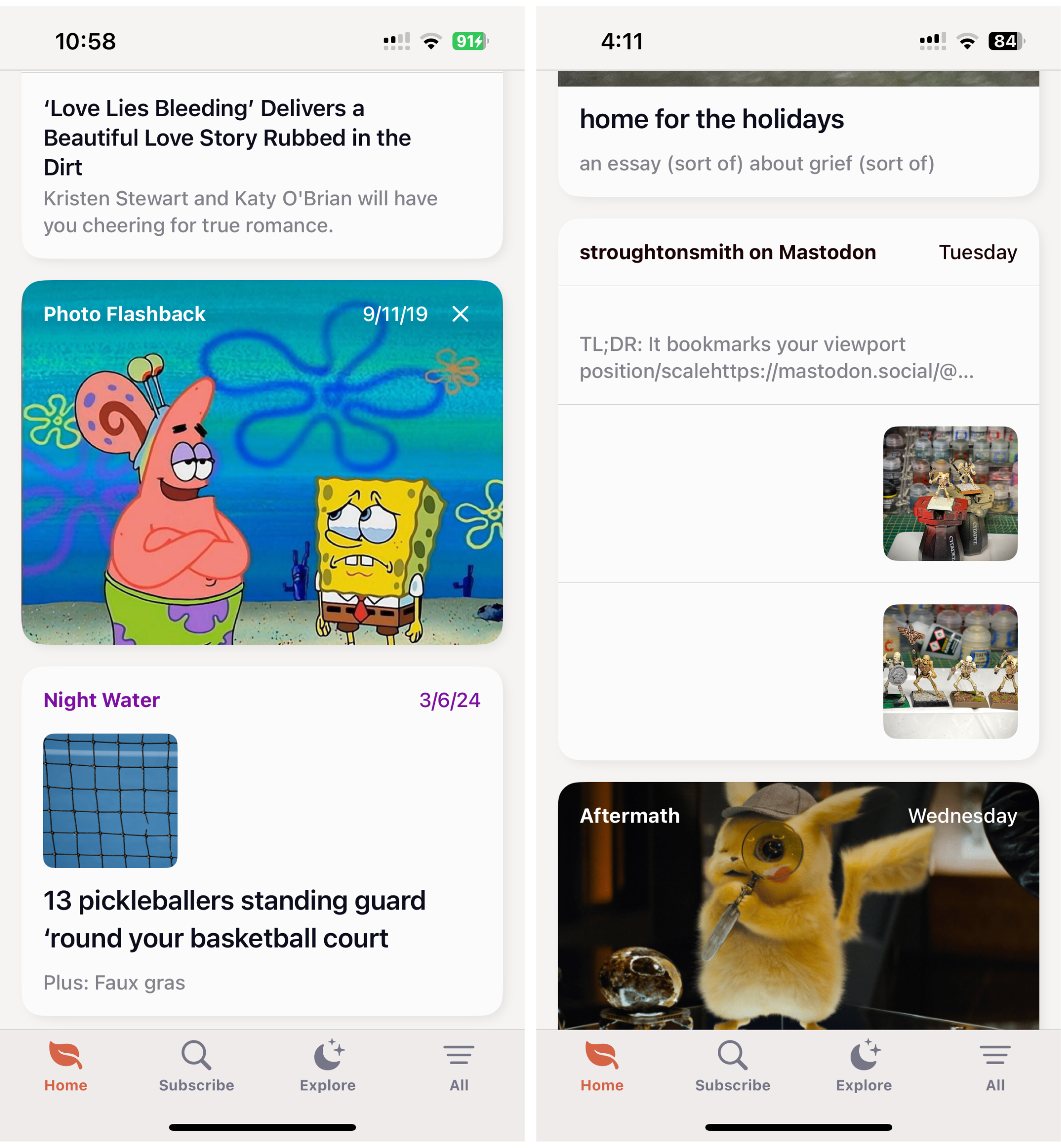The endless feeeed
Rethinking the infinite scroll

What is the number one thing you do on your phone? Maybe messaging or social media, you think. I’d hazard a guess that it’s something more fundamental: scrolling. Almost every app has been reduced to a feed with no end, an infinite scroll. The tweets keep coming, there’s always another TikTok, and Instagram is more than happy to bolster a lackluster feed with suggested and sponsored posts. That’s the crux of the problem: it’s your feed, but it never really feels like yours.
feeeed, an iOS app from developer Nate Parrott, aims to fix that problem with a relatively simple proposition: “What if you ran your own news feed?”, built out of websites, blogs, Twitter, YouTube, newsletters, TikTok, the weather, plus your personal data like photos, step count, and reminders. You can replace the endless feeds of social media with sources you control while maintaining their lean-back consumption model.
In practice, feeeed is primarily an RSS reader with a few bells and whistles. Thanks to RSS, you can not only follow websites and blogs, but Substack publications and Mastodon accounts. Outside of RSS, you can pull in YouTube channels, non-Substack newsletters via Gmail, subreddits, Hacker News, and Twitter accounts (supposedly—this “experimental” feature doesn't work for me). You can also see part of a website in your feed, like a small window into a frequently updated homepage.
It’s a particularly enticing proposition to me as an ex-RSS power user. RSS is an incredible protocol, allowing users to easily check if a website has new content without needing to navigate there. I fell in love with RSS in middle school when I realized I could pin the RSS feeds for my favorite webcomics in Firefox’s toolbar. After the discontinuation of Google Reader and the slow decline of blogging, I realized it would be just as easy—and in many ways, better—to organize all of my favorite sites and creators into Twitter lists instead. Now, with Twitter dead and a shittier X rising from the ashes, it might be time to revitalize the tried and true RSS protocol.

Unfortunately, despite the grand vision of a universal feed, the reality of using feeeed fell short for me. Using it to follow websites was pleasant enough—I think it would be a good reading app for sites that publish a lot of content where you don’t care about seeing every single post. But once you start layering in other sources it starts to fall apart. Turns out, it’s not a particularly good experience to mix in Reddit posts with Mastodon posts while throwing a YouTube video on top. I go to all these platforms for different reasons, and divorcing their content from their contexts doesn’t click like a blog post or newsletter. It doesn’t help that feeeed isn’t particularly good at displaying Reddit or Mastodon posts—they're a pain to interact with using the app, partially due to substandard mobile web experiences.
And I’ll admit it: I missed seeing trending or viral articles that I otherwise wouldn’t have read. I know, I know: the whole point is to choose my own sources! But what if I want the faceless internet mob to be a source? Evening a “trending now” or “hot articles” source, cultivated just from feeeed’s user base, would be better than nothing.
Parrott’s day job is working on Arc, my current internet browser of choice, and there's a certain amount of familial resemblance in the design. I’d love to see something like feeeed integrated into Arc as a superpowered version of Firefox’s old Live Bookmarks. That might not be the full social feed replacement like Parrott envisions, but it would be a useful tool for people reevaluating their relationship with platforms.
While RSS for blogs and websites has mostly fallen out of popular use, you’re likely familiar with one major use of the technology that’s still going strong: podcasts. Depending on who you ask, RSS is either the magic sauce that has allowed podcasting to stay open, creative, and weird, or it’s an anchor weighing down the industry and stopping it from reaching its full potential (try and guess which side I’m on). Last month, Ernie Smith wrote a great story on his blog Tedium where he imagines a few ways RSS could evolve to meet the needs of publishers and reduce reliance on closed platforms like Substack. You can read it here—I estimate it’ll take about five minutes.
I see feeeed as a repudiation of social platforms and their algorithms—I’ll pull in tweets and Reddit posts, but on my terms—but I don’t think social media is a dead end. Bluesky, in particular, has a vision for a modular and decentralized social network that’s more user-friendly than the long-running Mastodon, and I’ve been enjoying my time there these past few months.
One of its most interesting concepts is custom feeds. They’re like super-powered Twitter lists, but instead of curating a specific group of accounts, custom feeds algorithmically generate a timeline based on rules. These rules can be simple—show me cat pics—or very complex, like Skygaze’s “For You” feed, which learns what you like and aims to show you similar posts from across Bluesky. I don't know how they've managed it, but it’s one of the best algorithmic recommendation feeds I’ve ever used. Another feed I’ve been enjoying is Quiet Posters, which surfaces posts from people you follow who are infrequent posters. It’s a great way to ensure you don’t miss people you want to hear from in the infinite scroll.
Algorithms get a bad rap, but that’s usually because we don’t understand them—or we understand all too well that the companies behind those algorithms are designing them to keep us scrolling by any means necessary. Bluesky aims to pull back the curtain a bit and put you in control of the algorithms so that they serve you, not the interests of the platform. To that end, anyone can create and publish custom feeds either by coding them themselves or using a feed-building tool like Skyfeed. I used Skyfeed today to create a simple timeline that surfaces every post with a link to Night Water. Perhaps more useful is this feed of links from New York Magazine and its related properties. Both of these took me under five minutes to build and publish. From there, anyone can subscribe to a custom feed or even pin it to the app’s homepage, keeping it just one tap away.
In some ways, this concept is a mirror image of feeeed. Instead of creating a universal feed that brings in everything you’d like to see, with Bluesky, you can slice and dice the firehose of posts into something more digestible. It also makes it easier to turn topics off and avoid doomscrolling. Don’t want to look at election news on the weekend? Don’t tap the feed!
This past year (and change) since Elon Musk took over Twitter has been a fruitful time to rethink the way we scroll, with a lot of creative people introducing new tools and platforms to help put us back in control. There’s a lot of doom and gloom about the future of the internet—the decimation of media, large-scale AI theft—but to me, this is a silver lining. At least for now—show this to me in ten years when I'm still bemoaning the death of Google Reader.




